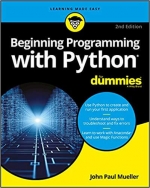Beginning Programming with Python. J. P. Mueller

Категория: Python
Поделиться:
Python is an example of a language that does everything right within the domain of things that it’s designed to do. This isn’t just me saying it, either: Programmers have voted by using Python enough that it’s now the fifth-ranked language in the world. The amazing thing about Python is that you really can write an application on one platform and use it on every other platform that you need to support. In contrast to other programming languages that promised to provide platform independence, Python really does make that independence possible. In this case, the promise is as good as the result you get. Python emphasizes code readability and a concise syntax that lets you write applications using fewer lines of code than other programming languages require. You can also use a coding style that meets your needs, given that Python supports the functional, imperative, object-oriented, and procedural coding styles (see Chapter 3 for details). In addition, because of the way Python works, you find it used in all sorts of fields that are filled with nonprogrammers. Beginning Programming with Python for Dummies, 2nd Edition is designed to help everyone, including nonprogrammers, get up and running with Python quickly. Some people view Python as a scripted language, but it really is so much more. (Chapter 18 gives you just an inkling of the occupations that rely on Python to make things work.) However, Python it does lend itself to educational and other uses for which other programming languages can fall short. In fact, this book uses Jupypter Notebook for examples, which relies on the highly readable literate programming paradigm advanced by Stanford computer scientist Donald Knuth (see Chapter 4 for details). Your examples end up looking like highly readable reports that almost anyone can understand with ease.
Скачать
Комментарии